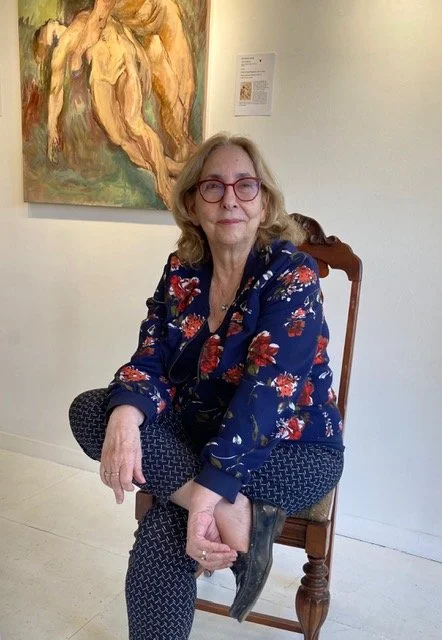Interview
Christine Viens
Originally from Amos, Quebec, Canada, Christine Viens lives and works in Montreal. After leading a career in judicial administration while developing an artistic practice, Christine Viens has devoted herself entirely to visual arts since 2009. She perfected her art during workshops in Paris at the École Nationale supérieure des Beaux-arts and at Studio Escalier, in New York at the New York Studio School of Painting, Drawing and Sculpting. She has collaborated on several collective exhibitions and produced individual shows. Her paintings can be found in several private collections.
What is your background and how did you start your journey in the art world?
“I have a legal background, and I pursued a career in the Criminal Justice system successively as a policy advisor, criminal prosecutor, and a director of Victim’s Aid Bureau and Judicial administrator. In the meantime, I nurtured a practice in visual arts. Since 2009, I have focused solely on artistic pursuits. In 2014, I co-founded the Académie des Beaux-Arts de Montréal, where I taught composition and later served as the executive director from 2020 to 2022. My interest in drawing and painting began in my teenage years, leading me to study with various artists in Quebec City where I studied law and later in Montreal, where I now live. Engaging in group exhibitions and solo shows since 2004, including my latest exhibition ‘The Speaking Body’ in 2024, has been a significant part of my artistic journey.”
What inspires you?
“I am inspired by the human and animal conditions. I examine how we navigate our vulnerability and resilience as beings on this shared planet.”
What themes do you pursue? Is there an underlying message in your work?
“I am focused on exploring how our body language can convey our emotions and inner experiences. Having the power to bridge cultural, geographical, age, and gender gaps. Emotions are a universal part of being human, understood by everyone no matter their background. Feelings like joy, sadness, anger, or love create a shared language that connects people. Through art, we break down barriers, showing our common humanity and bringing people closer together.”
How would you describe your work?
“My work is rooted in realism expanding on abstraction. As a figurative painter, my work is characterized by contrasts, a mix of bold and more controlled strokes, vibrant and subdued colors. Moreover, I am deeply interested in the depiction of movement, capturing the dynamic essence of the human form in motion. Working primarily with oil, I create expressive figures that convey raw emotion and energy, blending abstraction with the recognizable. Through my art, I strive to portray the complexity and depth of human experience, always in motion.”
Which artists influence you most?
“Over the years, I have drawn inspiration from artists like Lucian Freud, Max Beckmann, Ernst Ludwig Kirchner, Emil Nolde, Willem de Kooning, and most recently, Peter Paul Rubens and the Baroque movement. These artists have in common their ability to express intense emotion and the physicality of the human form. Whether through Freud’s raw psychological depth, Beckmann’s bold figures, or de Kooning’s gestural abstraction, they all focus on the human body as a vehicle for profound expression. Rubens with his dramatic compositions and mastery of movement and light, has resonated with me, echoing the themes of energy and emotional intensity that I seek to capture in my own work.”
“My work is rooted in realism expanding on abstraction. As a figurative painter, my work is characterized by contrasts, a mix of bold and more controlled strokes, vibrant and subdued colors.”
What is your creative process like?
“My creative process begins with research on the chosen theme, gathering inspiration from images and books about the artists who influence me. Working in series, I immerse myself in this visual and conceptual exploration. I start each piece by sketching the composition in loose lines with oil and charcoal, allowing the forms to develop organically. I then introduce colors tentatively, experimenting and adjusting as I go. I push and pull both color and line, building up multiple layers until I reach a point of satisfaction. Often, I work on two or three paintings simultaneously, allowing ideas to flow between them, enriching each piece in the process.”
What is an artist’s role in society and how do you see that evolving?
“The artist's role in society is diverse, including inspiring, reflecting social values, entertaining, educating, and more. As society changes, so too does the artist’s role. In contemporary times, some artists have become agents of social change, using their work to address pressing issues like climate change, identity, social justice, and technology. Others are satisfied with the decorative aspect of their work partnering with designers. I believe each artist defines their unique role by selecting their themes and medium. In my own perspective, I strive to nurture meaningful thoughts and create aesthetically pleasing visuals.”
Have you had any noteworthy exhibitions you'd like to share?
“I am delighted with my last exhibition titled ‘The Speaking Body.’ This series explores the universal language of emotions through art, reflecting on how our bodies communicate our inner lives. By revisiting iconic Baroque works, it connects us to a collective emotional memory where grief, pain, indignation, and passion testify to the human condition throughout the ages. This dialogue between past and present captures the essence of timeless feelings, using the body as a vector.”
Website: christine-viens.ca
Instagram: @christine_viens
Other links: www.facebook.com/christine.viens.3













